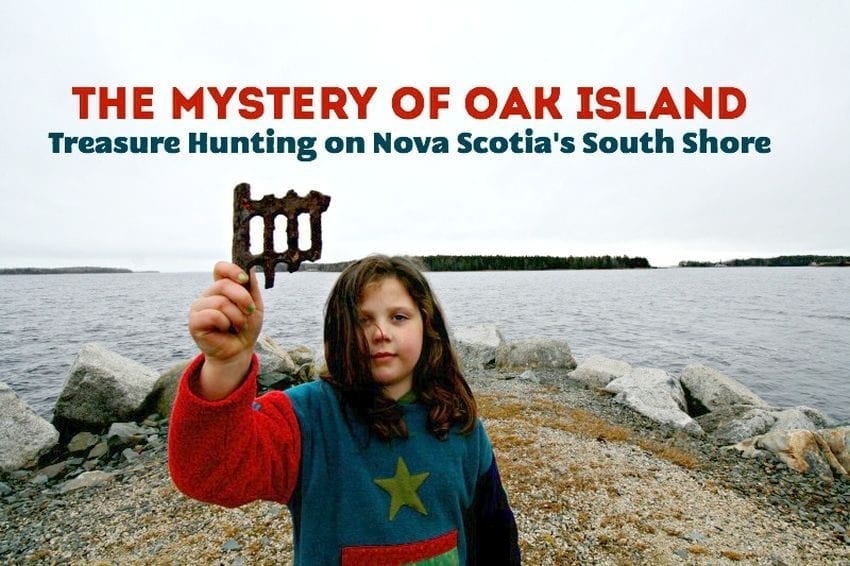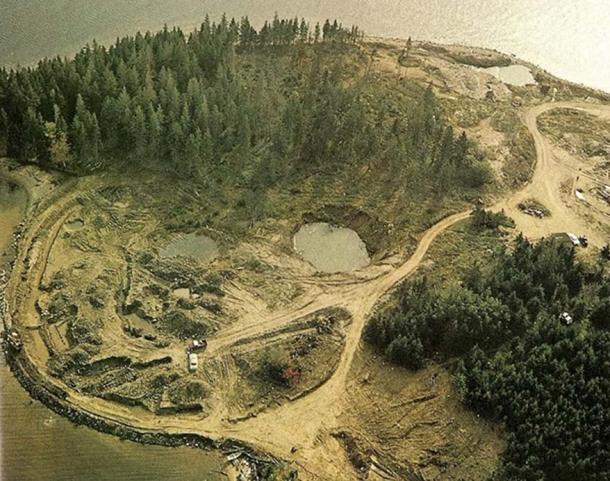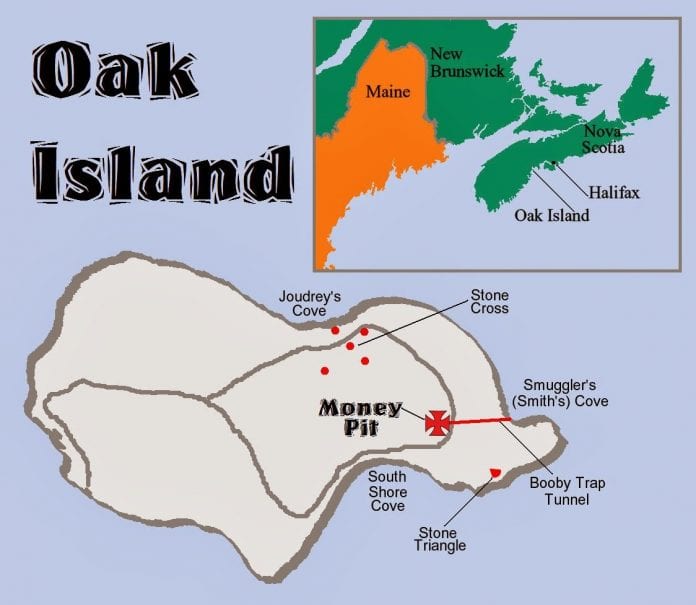There are many legends and stories about the Oak Island which is located in Mahone Bay off the coast of Nova Scotia in Canada. It all started with young Daniel McGinnis in 1795 when he found a rope tied to a branch of an oak tree. The ground in front of it appeared to be slumped. He called friends to help him dig since he believed that there could be the treasure and after several hours they found a wooden chest. Even though they wanted to continue exploring, a flood came and prevented them. That was the beginning of Oak Island treasure hunt, and people from all across the world have tried to find it. Interestingly, a lot of the stories about Oak Island contain motifs related to Freemasons, and there are some Masonic links to the legend.
Treasure Hunt
In 1795, this group managed to find a layer of flagstones, a shaft, and some wooden logs. They were unable to continue the hunt, but they returned sometime between 1803 and 1810 funded by a wealthy businessman when they found nine levels of the shaft marked by wooden platforms. The lowest level contained a plate with a strange inscription whereas the container they found was hollow.

These early excavations are well-known, but there is a possibility that they are not true. The treasure hunting started even earlier, back in the 1780s but the first recorded evidence dates back from 1849 when a treasure hunting company called Truro Company got the permission from the Nova Scotia governor to dig on the island. After the failure, they returned to the site in 1861 and stayed there until 1865 to come back once again from 1866 to 1867, but nothing was found. Many have tried after that, but they would all leave the island empty-handed.
The Oak Island Legend
Today, the legend is clear and detailed but that wasn’t always a case. The earliest versions suggest that Captain Kidd, a figure based on William Kidd (1654-1701) hid the treasure. Kidd, who was a Scottish sea captain, ended up executed for piracy. The articles regarding the treasure were published in 1861 and 1862. It is interesting that those published prior 1862 failed to mention the nine platforms whereas those published before 1861 didn’t mention the hollow container. Other elements of the story were added later. Such elements are the three gold-chain links discovery that happened around 1850 and three oak trees which form a triangle around the money pit.

The articles before 1861 were vague about the details, whereas the first mention of the 1795 exploration happens in 1897 – 100 years later. These differing accounts made many people believe that there is nothing on the island and some of the more skeptical investigators claimed that the pit is nothing but a sinkhole and wooden planks that were found were fallen logs that got washed in the sinkhole. This makes sense especially when you take a look at the geology of the island, which is mostly composed of limestone where caves are formed as water steeps. The limestone country rock is dissolved, thus creating near surface caves which can collapse without any warning and form slumps. The terrain has significantly changed, and we don’t know what Money Pit looked like originally before the digging started. In other words, we cannot tell whether the Money Pit is a human-made or something shaped by nature.
Nine Levels and Other Masonic Links
Many elements regarding the Oak Island Legend were added after 1861, and these parts fit the allegorical stories behind the initiation ceremonies of certain degrees of the Scottish Rite of Freemasonry. What this means is that the treasure hunters, many of whom were Freemasons themselves, embellished the story about the treasure. Now it is the right time to mention Holy Royal Arch and Royal Arch of Enoch. We will talk about the former first.
When the Jews went back to rebuild the temple in 534-516 BC, they found King Solomon’s secret vault. The stone was discovered inside the vault, but it was hollow when they hit it, but they also found a golden plate with the secret name of God inscribed on it. The Royal Arch of Enoch takes place around 1000 BC during the construction of King Solomon’s first temple. During the construction, the workers found the ruins of the underground temple built by Enoch, who is mentioned in the Book of Genesis. Believe it or not, but the temple had nine level, and at the bottom level, they found a gold plate bearing the secret name of God.
No matter what you believe in, there is a clear parallel between these two Masonic tales and the Oak Island treasure story. With nine levels discovered by digging, a hollow stone and a hollow container, a gold plate with the secret name of God in the tales and a stone plaque with the odd inscription on the Island. There are more examples, and one of them is a stone with an iron ring found in a pit nearby the main pit. The first level of Enoch’s temple had a stone with a metal ring. Also, the three gold chain links are connected with Masonry while the three oak trees that form a triangle around the Money Pit fit the motif where the secret name of God is inscribed within an equilateral triangle on a golden plate.
So, Freemasons created Most of the Oak Island Legend?
Jotham Blanchard McCully (1819 – 1899) wrote an article in 1862 which was published in a Nova Scotia newspaper. He was a part of the treasure hunt 13 years before he wrote the article and supported the claims of the existence of treasure. He mentioned all the evidence to support the story and most of those evidence had Masonic references. Even though it was not official, we could say that McCully was a Freemason. The letter from 1874 was discovered, sent to a Masonic lodge in Nova Scotia and it asked someone named McCully to take the latter for safekeeping after it is being read. We also need to mention that most of the treasure hunters on the Oak Island had Masonic connections and that they created legends and theories about the treasure.
There are several theories for these connections with Freemasons. No treasure was found, and perhaps McCully used the symbols as the way to warn the other Freemasons not to waste their time on the hunt. The other possibility was that McCully believed that the treasure existed and he used the symbols to throw other Freemasons off the track. And this is the reason why he would present fake evidence. Even though McCully spent 18 years of his life looking for the treasure, there is a lack of evidence to support each claim. But since he spent so many years looking for it, he probably believed the treasure existed.
Conclusion
The last two men who have been searching the treasure have been Rick and Marty Lagina. They even have their own show called The Curse Of Oak Island, and even though they have brought modern equipment and looked everywhere, they found nothing, just like the people before them. Unfortunately for all those who want the treasure to be found, we have some bad news. There is probably no treasure at all because of so many conflicting narratives. Did the Freemasons had any connections with the Oak Island? Probably yes, and they had a good laugh. What is your view on the topic? Do you believe that the treasure exists? Why? Why not?









